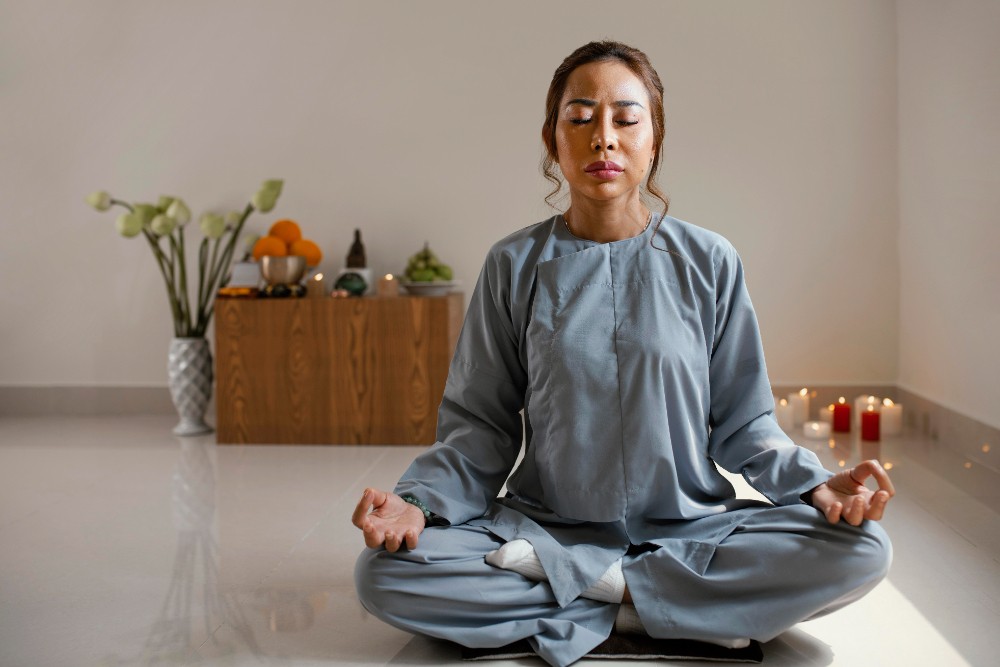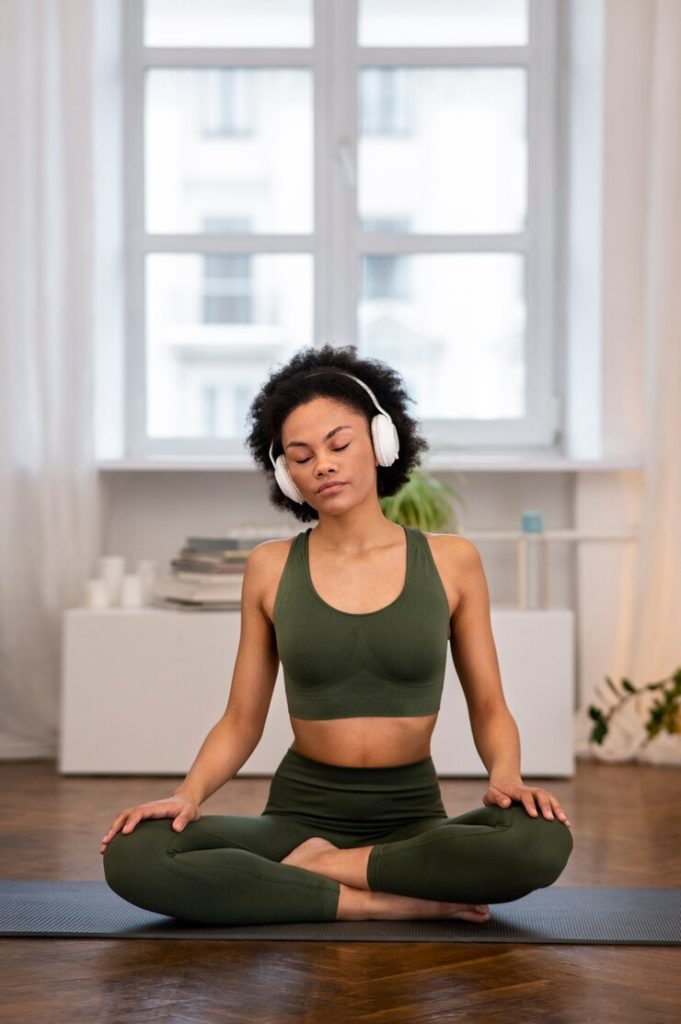How Yoga and Ayurveda work together for Holistic Health ?
Yoga and Ayurveda are known to be sister sciences as both are amalgamated branches of Vedic knowledge. The main goal of Yoga and Ayurveda is to preserve the health of the individual and prevent them from falling prey to diseases. According to Ayurveda, yoga and its practices is a spiritual science of life. Ayurveda is the science of the body.
The yogic practices described by the father of yoga ,Patanjali, are very useful in maintaining good health, happiness and longevity. Patanjali described the eight limbs of yoga and yogic practices, namely: the natural regulation of the nervous system; discipline; cleansing; postures; concentration; contemplation, the awakening of awareness; and the state of perfect equilibrium.
Materials and Method :
Classical texts of Ayurveda such as Charaka samhita, Sushruta Samhita, Ashtanga Hridaya, and Classical texts of Yoga such as Hatha Yoga pradipika, Patanjali yoga sutra, Srimad Bhagwadgita, Gherand samhita were critically analysed and the fundamental principles were compared, interpreted and compiled.
The Relationship Between Yoga and Ayurveda
Yoga and Ayurveda are two interrelated branches of the same Vedic knowledge that originated in India. They are considered sister sciences that aim to harmonize the body, mind, and spirit. While Ayurveda focuses on the holistic and preventive aspects of health through diet, lifestyle, and herbal treatments, yoga emphasizes physical postures (asanas), breathing techniques (pranayama), and meditation to maintain overall well-being. Together, they provide a comprehensive approach to health and wellness.
Ayurveda specifies different yoga practices suited to an individual’s constitution (pitta, vata, or kapha). For example, a person with a pitta constitution should avoid holding the headstand posture for more than one minute to prevent mental disorientation. Individuals with a vata constitution should not perform shoulder stands for long due to the delicate structure of their seventh cervical vertebra, which could lead to spinal issues. This vertebra is sensitive and the delicate bone structure of vata may cause a shift in the spinal column. Repressed anger will shift the cervical vertebra to the right side and repressed fear will shift it to the left. The person of kapha constitution should avoid extended lotus posture to prevent pressure on the adrenal glands.
Breathing and Meditation (Pranayama) as per body constitution :
Pranayama involves breathing exercises that balance the conscious mind, bringing peace, love, joy, and enhanced creativity. Pranayama has many healing benefits and also affects creativity. Those practices bring bliss to life.
Different types of pranayama are recommended based on one’s constitution:
- Pitta constitution: Perform left nostril breathing (inhale through the left, exhale through the right) to create a cooling effect by enhancing female energy.
- Kapha constitution: Perform right nostril breathing (inhale through the right, exhale through the left) to create a heating effect by stimulating male energy.
- Vata constitution: Perform alternate nostril breathing to balance the active force of vata.
Treatment of Disorders through Yoga and Ayurveda:
- The healing of digestive problems:
The Ayurvedic approaches through herbs:
- Triphala: A blend of three fruits (amalaki, bibhitaki, and haritaki) that helps in detoxifying the digestive system, improving digestion, and relieving constipation.
- Ajwain (Carom seeds) and Fennel Seeds: Chewing these seeds after meals can aid in digestion and prevent gas and bloating.
Recommended Yoga practices:
- Pavanamuktasana (Wind-Relieving Pose): This pose helps in releasing gas from the stomach and intestines, improving digestion and relieving bloating.
- Lie on your back, bring your knees towards your chest, and hug them with your arms. Lift your head towards your knees and hold the position.
- Bhujangasana (Cobra Pose): This asana stimulates abdominal organs and enhances digestive function.
- Lie on your stomach with your hands under your shoulders, lift your chest off the ground while keeping your lower body grounded.
- Easing joint pain with the knowledge of Ayurveda:
The Ayurvedic approaches through herbs:
- Ashwagandha: This powerful herb has anti-inflammatory properties that help reduce joint pain and stiffness.
- Nasya (Nasal Treatment): Applying medicated oils in the nostrils can alleviate joint pain by balancing the body’s energies.
Recommended Yoga Practices:
- Vrikshasana (Tree Pose): This pose improves balance and strengthens the legs and knee joints.
- Stand on one leg, place the other foot on the inner thigh of the standing leg, and bring your hands together above your head.
- Vajrasana (Thunderbolt Pose): This pose enhances flexibility and strength in the knee and ankle joints.
- Sit on your heels with your knees together, hands on your thighs, and spine straight.
- Tackling sleep disorders with Ayurveda:
The Ayurvedic approaches through herbs:
- Brahmi: This herb calms the mind and helps in achieving restful sleep.
- Abhyanga (Oil Massage): Massaging the body with warm sesame oil reduces stress and promotes deep sleep.
- Shavasana (Corpse Pose): This pose induces complete relaxation, reducing stress and anxiety.
- Lie flat on your back with arms by your sides, palms facing up, and focus on your breath.
- Yoga Nidra (Yogic Sleep): A guided meditation practice that promotes deep relaxation and improves sleep quality.
- Removing Acidity in the body with Ayurveda:
The Ayurvedic approach through herbs:
- Amla (Indian Gooseberry): Amla is known for its cooling properties and helps in reducing acidity and heartburn.
- Jeera (Cumin Seeds): Drinking cumin seed water helps in neutralizing stomach acids and improving digestion.
Recommended Yoga Practices:
- Vajrasana (Thunderbolt Pose): Sitting in this pose after meals helps in enhancing digestion and reducing acidity.
- Kneel and sit back on your heels, keeping your back straight and hands on your thighs.
- Uttanpadasana (Raised Leg Pose): This pose activates the digestive system and helps in reducing acidity.
- Lie on your back, raise your legs to a 45-degree angle, and hold the position.
- Relieving constipation with Ayurveda:
The Ayurvedic approach through herbs:
- Triphala: Known for its mild laxative effect, triphala helps in regulating bowel movements and relieving constipation.
- Isabgol (Psyllium Husk): Isabgol is a natural fiber that helps in softening the stool and easing bowel movements.
Recommended Yoga Practices:
- Pavanamuktasana (Wind-Relieving Pose): This pose aids in relieving constipation by stimulating the intestines.
- Halasana (Plow Pose): This pose activates the digestive organs and helps in relieving constipation.
Yoga Postures for Vata, Pitta, Kapha Ailments
Yoga Asanas for Vata
Ailments | Postures | |
1 | Vata Type of Asthama | Backward Bend, Halasana, Knee to Chest, Corpse |
2 | Backache | Knee to chest, Plough, Half Wheel, Backward Bend |
3 | Constipation | Backward Bend, Yoga Mudra, Knee to Chest, Should Stand, Corpse. Belly should be drawn in while doing postures. |
4 | Depression | Yoga Mudra, Plough, Corpse, Palm Tree, Lotus |
5 | Sciatica | Knee to Chest, Backward Bend, Plough, Yoga Mudra, Half Wheel |
6 | Sexual Debility | Backward Bend, Plough, Shoulder Stand, Elevated Lotus |
7 | Varicose Veins | Head Stand, Backward Bend, Corpse |
8 | Wrinkles | Yoga Mudra, Backward Bend, Head Stand, Plough |
9 | Rheumatoid | Half Wheel, Bow, Plough, Head Stand, Backward Bend |
10 | Headache | Plough, Yoga Mudra, Head Stand |
11 | Insomnia | Corpse, Cobra, Backward Bend |
12 | Menstrual Disorders | Plough, Cobra, Hald Wheel, Yoga Mudra |
Ailments | Postures | |
1 | Peptic Ulcer | Hidden Lotus, Sheetali (inhale through coiled tongue through mouth) |
2 | Hyperthyroidism | Shoulder Stand, Ear Knee |
3 | Malabsorption | Knee to Chest, Fish, Locust |
4 | Hypertension | Shoulder Stand, Cobra, Half Bow, Quiet Breathing |
5 | Anger or Hate | Half Bow, Shoulder Stand, Hidden Lotus, Corpse |
6 | Migraine Headache | Sheetali, Shoulder Stand, Fish |
7 | Colitis | Fish, Ear Knee, Boat, Bow |
8 | Liver Disorder | Fish, Shoulder Stand, Ear Knee, Hidden Lotus |
9 | Hemorrhoids | Fish, Shoulder Stand, Bow |
10 | Stomatitis (Inflammation of the Tongue) | Sheetali |
Yoga Asanas for Kapha
Ailments | Postures | |
1 | Bronchitis | Head Stand, Plough, Forward Bend, Backward Bend, Half Wheel, Fish |
2 | Emphysema | Ardha chakrasana, shoulder stand |
3 | Sinus Congestion | Fish, Boat, Plough, Bow, Bhastrika |
4 | Sinus Headache | Lion, paschimottanasana, Matsyasana |
5 | Diabetes | Boat, Fish, Half Wheel, Backward Bend, Forward Bend |
6 | Chronic Gastro-Intestinal Disorders | Fish, Locust, Cobra |
7 | Sore Throat | Lion, Shoulder Stand, Locust, Fish |
8 | Asthma | Ardha chakrasana, Bow, Boat, Shoulder Stand, Tadasana Tree, Fish, Cobra |
Asanas for Derangement of Vata, Pitta, Kapha
Dosha and Special Seat in the Body
VATA Movement Producing Humour | PITTA Heat Producing Humour | KAPHA Structure Producing Humour |
Seat of Vata Colon, Pelvic Cavity | Seat of Pitta Small Intestine | Seat of Kapha Chest, Stomach |
Qualities | ||
Dry, Light, Cold, Subtle, Rough, Moving, Clear | Oily, Sharp, Hot, Light, Sour Smell, Liquid, Fluid | Cold, Oily, Heavy, Slow, Steady, Smooth, Dense |
Asanas that Balance Derangement of Dosha
VATA | PITTA | KAPHA |
Asanas that place pressure on the pelvic and colon areas. Asanas done with slow, regular, silent breathing. Meditative asanas that put pressure on the lower abdomen and make the body well grounded. Balancing asanas that increase concentration making Prana smoother and finer. | Asanas that affect the navel area, increase gastric heat efficiency and stimulate digestion. Asanas that stimulate liver, spleen and small intestines, and strengthen gastric fire (agni). | Asanas that work on the chest, stomach and head areas bringing energy into the seat of Kapha. Strengthening asanas that increase flexibility and reduce fat and Kapha. |
Lotus, Backward Bend, Head Knee, Plough, Locust, Corpse, Cobra, Knee to Chest, Head Stand | Hidden Lotus, Ear Knee, Bow, Fish, Shoulder Stand, Half Wheel, Sheetali | Spinal Twist, Boat, Lion, Head Knee, Palm Tree, Half Wheel |
Example and illustration
Causes and management in Migraine
Migraines can be caused by hormonal changes, certain foods or drinks, stress, sensory stimuli changes in environment. Lifestyle changes may involve identifying avoiding triggers, maintaining a regular sleep schedule, staying hydrated, managing stress through relaxation techniques or therapy regular exercise. Acute treatments involve medications such as triptans, nonsteroidal anti-inflammatory drugs (NSAIDs), or anti-nausea medications. It’s essential for individuals with migraines to work closely with their healthcare providers to develop a personalized management plan.
Yoga in Migraine
Yoga can be beneficial for migraine management by reducing stress, improving blood circulation, and promoting relaxation. Practices like gentle stretching, deep breathing, and meditation can help alleviate migraine symptoms and prevent future episodes. However, it’s essential to consult with a healthcare professional before starting any new exercise regimen, especially if you have health conditions like migraines.
Ayurveda and yoga also offer holistic approaches in healing Maternal and child health . Ayurveda and yoga if implemented along with modern healthcare systems can improve heathen mother and child promoting healthy development of children and reducing mortality rate thus helping the society.
Yoga for Eyes and Eye disorders
Yoga can be beneficial for eye health and certain eye disorders. Some yoga practices that are specifically targeted towards improving eye health include:
Palming : Rub your palms together to generate heat, then gently cup your eyes with your palms without applying pressure. This relaxes the eye muscles and soothes the nerves.
Eye rotations : Sit comfortably and slowly rotate your eyes in a clockwise and then counterclockwise direction. This helps improve flexibility and blood circulation in the eye muscles.
Blinking : Sit with your eyes closed and blink rapidly for about 30 seconds.
This helps to lubricate the eyes and reduce strain.
Trataka : This involves gazing steadily at a single point, such as a candle flame or a black dot on a wall, without blinking. It helps improve concentration and focus, which indirectly benefits eye health.
Eye exercises : These include techniques like focusing on near and distant objects alternately, as well as moving your eyes in different directions to improve flexibility and coordination.
For specific eye disorders like myopia (nearsightedness), hyperopia (farsightedness), astigmatism, or even conditions like dry eyes or eye strain due to prolonged screen time, practicing these yoga techniques regularly alongside proper medical care may provide some relief and help maintain overall eye health.
Benefits of Dhyana in Eye disease
Dhyana, or meditation, can potentially benefit eye diseases by reducing stress, which is known to exacerbate certain eye conditions like glaucoma and dry eye syndrome. Additionally, meditation may promote overall relaxation, which can help alleviate tension in the eye muscles and improve circulation to the eyes, potentially aiding in conditions like eye strain and fatigue.
Benefits of Pranayama in Eye disease
Pranayama, or yogic breathing exercises, can have several benefits for eye health. Deep breathing techniques can help improve circulation, reduce stress, and enhance oxygenation, all of which can positively impact eye health. Specific pranayama exercises like Bhramari pranayama (humming bee breath) and Kapalabhati (skull shining breath) are believed to have a direct influence on eye health by promoting relaxation, reducing strain, and improving overall well-being.
Benefits of Meditation in Eye disease
Meditation can offer several benefits for eye diseases like reducing stress, which is linked to conditions like glaucoma and macular degeneration. Additionally, meditation may improve overall blood circulation, which can support eye health.
Discussion
The fundamental concepts of both the sciences are inseparable and an integrated approach of Yoga and Ayurveda can effectively deliver all the dimensions of Health and are valuable in Prevention of Lifestyle disorders . Yoga is the science of union with the Ultimate Being. Ayurveda is the science of living, of daily life. When yogis perform certain postures and follow certain disciplines, they open up and move energies that have accumulated and stagnated in the energy centers. When stagnant, these energies create various ailments. Yogis may temporarily suffer physical and psychological disorders because in the course of yogic cleansing of the mind, body and consciousness, disease-producing toxins are released.
Conclusion
Yoga and Ayurveda together offer a comprehensive system of health and wellness, addressing both physical and mental aspects of well-being. While Ayurveda provides dietary, herbal, and lifestyle recommendations to balance the body’s energies and treat disorders, yoga supports these treatments through physical postures, breathing techniques, and meditation.
By integrating these sister sciences into daily life, individuals can effectively manage and prevent various health issues, leading to a balanced and harmonious life.
Reference
- Charaka samhita
- Sushruta samhita
- Ashtanga Hridaya
- Hathayoga
- Patanjali yoga sutra , samadhipada , Swami vivekananda
- Patanjali yoga sutra samadhipada , Swami vivekananda
- Patanjali yogasutra sadhanapada , Swami vivekananda
- Yoga therapy
- Ayurveda: The Science of Self-Healing – By Dr. Vasant Lad





